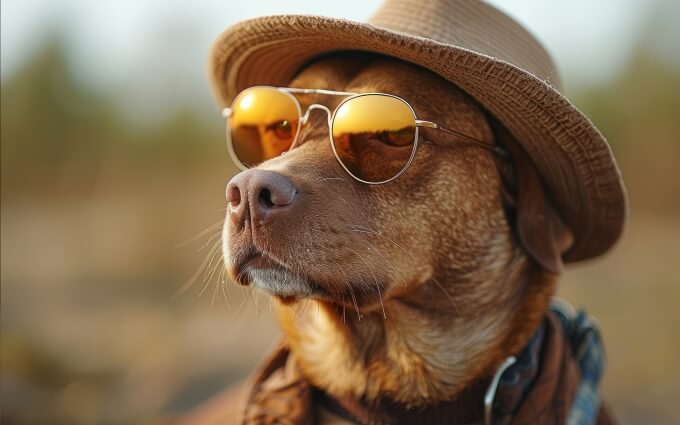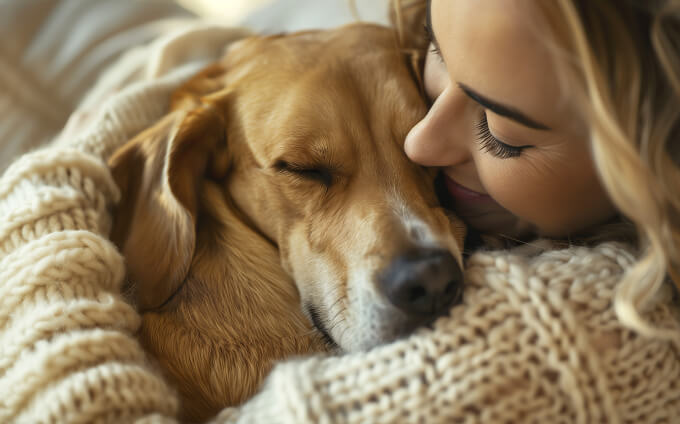- Home
- Dog health
- Can dogs see what's on TV? Understand your dog's vision
Can dogs see what's on TV? Understand your dog's vision
You've probably seen your dog staring at the TV and wondered what they're actually seeing. But how do dogs perceive television, what colors they see, and how does their visual experience differ from ours?

- 19

What do dogs really see on TV?
You've probably seen your dog staring at the TV and wondered what they're actually watching. Dogs watch TV, but their visual experience is very different to ours. Humans have three types of color-perceiving cells in their eyes, while dogs only have two. This means they primarily see the world in shades of blue and yellow. Colors like red and green are perceived as more muted greys, which can make it difficult for them to distinguish between objects on the screen.
Motion and attention
Although dogs' color vision is limited, they have an advantage in being able to perceive motion better than us. Dogs' eyes have more cells responsible for detecting motion, making them more sensitive to rapid changes on the screen. Older televisions with lower refresh rates can appear flickering to dogs, while modern televisions with high refresh rates provide a smoother and more coherent visual experience for them.
What type of content captures their interest?
You may have noticed that your dog reacts when there are animals or other dogs on screen. Dogs can recognize images of other dogs and often respond to sounds like barks and other animal noises. However, it's important to remember that not all dogs are interested in television. Some may ignore it completely, while others will be fascinated by certain images and sounds.
Tips to make TV time more enjoyable for your dog
- Place the TV at eye level with your dog to make it easier for them to see the screen.
- Select programs with nature content or shows with many animals and bright colors that dogs can perceive.
- Use interactive toys or treats to make the experience more engaging.
Sounds also play a role
Since dogs can't use their strongest sense - smell - to interact with the TV, sounds are important to them. Sounds like doorbells, squeaky toys and other animal noises can grab their attention. If your dog isn't interested in the visual content, they may still show interest in the sounds coming from the TV.
Beware of too much screen time
While watching TV can be entertaining for your dog, it's important to balance it with physical activity and mental stimulation. Too much screen time can lead to overexcitement or frustration. Make sure your dog still gets plenty of play and social interaction away from the screen.
Frequently Asked Questions about dogs watching TV
Can dogs really see what's on TV?
Yes, dogs can see images on TV, but they perceive them differently than humans due to their vision and color range.
Do dogs enjoy watching TV?
Some dogs enjoy the movement and sounds on TV, while others may not show much interest at all.
What colors can dogs see on TV?
Dogs see mainly in shades of blue and yellow, so TV images appear less colorful to them than to humans.
Why does my dog bark at the TV?
Your dog may react to movement, animals, or sounds on the screen as if they were real.
Is it okay to leave the TV on for my dog?
Yes, leaving the TV on can provide background noise and stimulation, but it should not replace exercise or interaction.
- 19
 Marcin Solgaard
Marcin Solgaard
Marcin is a true dog enthusiast! He is always seen with his 9-year-old boxer by his side. Marcin believes that dogs thrive on love, fun and positive experiences. On their daily adventures, people often stop Marcin to ask how his boxer is so happy and well-behaved. He happily shares tips on dog behavior and fun activities to create a happy and harmonious life with your dog.
-
Dog health
 Are Dogs Really Color Blind? The Truth About Canine Vision
Are Dogs Really Color Blind? The Truth About Canine VisionDiscover how dogs see the world, what colors they can perceive, and the science behind their unique vision. This blog post delves into the myth of dogs being color blind and explains their actual color perception.
 Marcin SolgaardMay 26, 202433
Marcin SolgaardMay 26, 202433 -
Food & Nutrition
 The Best Foods to Boost Your Dog's Immune System
The Best Foods to Boost Your Dog's Immune SystemTo keep your dog healthy and resilient, fueling their immune system with the right foods is key. In this post, we'll cover the top nutrient-packed foods that can give your dog's immune system the support it needs, helping them fend off illness and stay energetic.
 Marcin SolgaardOct 04, 20249
Marcin SolgaardOct 04, 20249 -
Dog Behavior
 Does My Dog Know I Care About It?
Does My Dog Know I Care About It?Discover the ways your dog shows it knows you care and how you can reinforce that loving bond through simple actions and daily interactions.
 Cassandra DalgaardAug 05, 202444
Cassandra DalgaardAug 05, 202444 -
Dog health
 Which Emotions Do Dogs Actually Experience? Understanding Your Dog's Emotions
Which Emotions Do Dogs Actually Experience? Understanding Your Dog's EmotionsDogs experience a variety of basic emotions similar to those of a young child. Learn about the emotions your dog truly feels, how they express them, and what it means for your relationship.
 Cassandra DalgaardJul 30, 202478
Cassandra DalgaardJul 30, 202478 -
Puppies & Young dogs
 How to Puppy-Proof Your Home: A Complete Guide
How to Puppy-Proof Your Home: A Complete GuideBringing a new puppy home is thrilling, but keeping them safe means some serious puppy-proofing. This guide covers everything from securing hazardous items to creating a puppy-friendly zone, making your home a safe haven for your curious new companion.
 Michelle TorringOct 10, 202412
Michelle TorringOct 10, 202412 -
Dog Behavior
 Do Dogs Dream? A Fascinating Look Into Your Dog's Sleep
Do Dogs Dream? A Fascinating Look Into Your Dog's SleepA lively, informative exploration of canine dreaming - from brainwaves and sleep stages to dream content and how to (or not to) wake a sleeping dog.
 Cassandra DalgaardSep 02, 20253
Cassandra DalgaardSep 02, 20253 -
Dog Behavior
 How to Help a Shy or Nervous Dog Build Confidence
How to Help a Shy or Nervous Dog Build ConfidenceHelping a shy or nervous dog build confidence takes time, patience, and the right techniques. With a structured approach, you can gradually encourage your dog to feel safe, secure, and ready to take on new challenges.
 Michelle TorringSep 22, 202415
Michelle TorringSep 22, 202415 -
Food & Nutrition
 How to Choose the Right Diet for Your Allergic Dog
How to Choose the Right Diet for Your Allergic DogFind out how to select the perfect diet for your dog with allergies. Learn about elimination diets, hypoallergenic foods, and the best ingredients to keep your furry friend healthy and happy.
 Marcin SolgaardJun 09, 202427
Marcin SolgaardJun 09, 202427 -
Food & Nutrition
 Dog Supplements: When and Why to Use Them
Dog Supplements: When and Why to Use ThemDog supplements can enhance your furry friend's health by filling nutritional gaps and addressing specific health issues. Learn when and why to use them.
 Michelle TorringAug 28, 202432
Michelle TorringAug 28, 202432 -
Dog Behavior
 Why Does My Dog Put Its Head on Me? Understanding the Behavior
Why Does My Dog Put Its Head on Me? Understanding the BehaviorEver wondered why your dog puts its head on you? This guide dives into the reasons behind this endearing behavior, from seeking comfort to showing love.
 Michelle TorringAug 03, 202428
Michelle TorringAug 03, 202428










